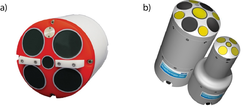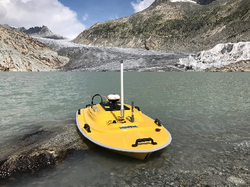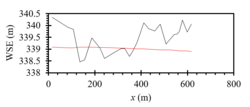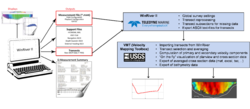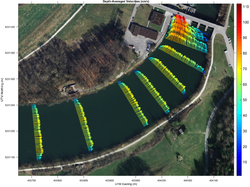LiDAR
Contents
Quick summary
Developed by:
Date:
Suitable for the following [[::Category:Measures|measures]]:
Introduction
Lidar is a measurement technique that measures the distance from a georeferenced laser sensor to a ground target by illuminating the target with the pulsed light (Figure 66). The sensor detects the reflected pulses. The time shifts in laser return and wavelengths can then be used to make digital 3-D representations of the target areas, e.g. a river section. The laser pulses can have different wavelengths, most commonly red and green.
The red laser is more common and therefore cheaper. However, other than the NeoDyn Yag laser it can not penetrate the water surface. Therefore the green laser (wavelength 532nm) is most preferred in scientific and especially river related measurements (Figure 67). However, a certain distance from the source of the light to the eye of any person passing accidentally the measurement must be guaranteed due to safety reasons. This is usually not a problem, as this application is used for large scale approached, mainly with so called Airborne Laser Scanning (ALS) where the laser is mounted to a small plane, a helicopter or even a large (more than 15 kg load) drone.
Application
As the laser and also the plane or helicopter are a quite expensive set of devices, the measurements are usually taken by private contractors. Most of the time the client is a municipality, the government or a hydropower operator interested in the geometry of floodplains and the bathymetry of rivers.
In Norway, most of the rivers are currently measured with a red laser (hence no underwater registrations). These are relatively easily available for research institutions through public website hoydedata.no. Also available at the website are green laser derived bathymetry of a selection of river reaches.
The penetration depth of the green laser through water depends highly on turbidity, flow velocity, reflections on the surface / waves and water depth. It also depends most probably on the type of suspended load. Thus, green laser measurements are in many cases supplied with echosounding data.
Problems can also be caused by any other overlap of objects such as trees above ground or submerged vegetation above river bottoms (Figure 68). This can lead to blurred areas and various z-data (height marker) for the same x/y coordinates.
The measurements generate a point cloud. Post-processing is usually done in a specific software (also freeware) as is the case many other applications (such as SfM). However, as it is a usual output format, it is not a specific part of the Lidar system.
Other information
The total costs for the geophone and accelerometer sensors amount to approx. 885-1'330 €. The costs for the field computer, the analog-digital-converter, and the 3G modem are approx. 5'300-6'200 €. The total costs for the Teledyne RiverPro 1200 kHz, Teledyne Q-boat and DGPS from Hemisphere Atlas link amount to approx. 22’000 €, 21’200 € and 3’340 € respectively. The costs of shipping, VAT, some mounting apparatus and long-range radio modem are excluded. For current costs of the equipment, we recommend to ask the corresponding supplier. Note that Q-boat can also house Sontek RiverSurveyor M9. Furthermore, a rugged laptop for field use is recommended.
Relevant literature
- Bizzi, S., Demarchi, L., Grabowski, R.C., Weissteiner, C.J., Van de Bund, W., 2016. The use of remote sensing to characterise hydromorphological properties of European rivers. Aquatic Sciences 78, 57–70. https://doi.org/10.1007/s00027-015-0430-7
- Brock, J.C., Purkis, S.J., 2009. The Emerging Role of Lidar Remote Sensing in Coastal Research and Resource Management. Journal of Coastal Research 10053, 1–5. https://doi.org/10.2112/SI53-001.1
- Brock und Purkis - 2009 - The Emerging Role of Lidar Remote Sensing in Coast.pdf, n.d.
- Costa, B.M., Battista, T.A., Pittman, S.J., 2009. Comparative evaluation of airborne LiDAR and ship-based multibeam SoNAR bathymetry and intensity for mapping coral reef ecosystems. Remote Sensing of Environment 113, 1082–1100. https://doi.org/10.1016/j.rse.2009.01.015
- Costa et al. - 2009 - Comparative evaluation of airborne LiDAR and ship-.pdf, n.d.
- Gao, J., 2009. Bathymetric mapping by means of remote sensing: methods, accuracy and limitations. Progress in Physical Geography 33, 103–116. https://doi.org/10.1177/0309133309105657
- Hilldale, R.C., Raff, D., 2008. Assessing the ability of airborne LiDAR to map river bathymetry. Earth Surface Processes and Landforms 33, 773–783. https://doi.org/10.1002/esp.1575
- Hilldale und Raff - 2008 - Assessing the ability of airborne LiDAR to map riv.pdf, n.d.
- Irish, J.L., White, T.E., 1998. Coastal engineering applications of high-resolution lidar bathymetry. Coastal Engineering 35, 47–71. https://doi.org/10.1016/S0378-3839(98)00022-2
- Kinzel, P.J., Legleiter, C.J., Nelson, J.M., 2013. Mapping River Bathymetry With a Small Footprint Green LiDAR: Applications and Challenges : Mapping River Bathymetry with a Small Footprint Green LiDAR: Applications and Challenges. JAWRA Journal of the American Water Resources Association 49, 183–204. https://doi.org/10.1111/jawr.12008
Langhammer, J., Janský, B., Kocum, J., Minařík, R., 2018a. 3-D reconstruction of an abandoned montane reservoir using UAV photogrammetry, aerial LiDAR and field survey. Applied Geography 98, 9–21. https://doi.org/10.1016/j.apgeog.2018.07.001
- Langhammer, J., Janský, B., Kocum, J., Minařík, R., 2018b. 3-D reconstruction of an abandoned montane reservoir using UAV photogrammetry, aerial LiDAR and field survey. Applied Geography 98, 9–21. https://doi.org/10.1016/j.apgeog.2018.07.001
- Lejot, J., Delacourt, C., Piégay, H., Fournier, T., Trémélo, M.-L., Allemand, P., 2007. Very high spatial resolution imagery for channel bathymetry and topography from an unmanned mapping controlled platform. Earth Surface Processes and Landforms 32, 1705–1725. https://doi.org/10.1002/esp.1595
- Lükő, G., Rüther, D.N., n.d. UAV BASED HYDROMORPHOLOGICAL MAPPING OF A RIVER REACH TO IMPROVE HYDRODYNAMIC NUMERICAL MODELS 1.
- Lükő, G., Rüther, D.N., n.d. UAV Based Hydromorphological Mapping of a River Reach to Improve Hydrodynamic Numerical Models.
- Marcus, W.A., Fonstad, M.A., 2008. Optical remote mapping of rivers at sub-meter resolutions and watershed extents. Earth Surface Processes and Landforms 33, 4–24. https://doi.org/10.1002/esp.1637
- Mallet C., 2010; LIDAR aéroportéstopographiques & bathymétriques ; https://www.umr-cnrm.fr/ecole_lidar/IMG/pdf/Mallet-Topo_Bathy_Veget.pdf
- Saylam, K., Brown, R.A., Hupp, J.R., 2017. Assessment of depth and turbidity with airborne Lidar bathymetry and multiband satellite imagery in shallow water bodies of the Alaskan North Slope. International Journal of Applied Earth Observation and Geoinformation 58, 191–200. https://doi.org/10.1016/j.jag.2017.02.012
- Wang, C.-K., Philpot, W.D., 2007. Using airborne bathymetric lidar to detect bottom type variation in shallow waters. Remote Sensing of Environment 106, 123–135. https://doi.org/10.1016/j.rse.2006.08.003
- Wang und Philpot - 2007 - Using airborne bathymetric lidar to detect bottom .pdf, n.d.
- Zhang, K., Yang, F., Zhang, H., Su, D., Li, Q., 2017. Morphological characterization of coral reefs by combining lidar and MBES data: A case study from Yuanzhi Island, South China Sea: MORPHOLOGICAL STUDY OF CORAL REEF. Journal of Geophysical Research: Oceans 122, 4779–4790. https://doi.org/10.1002/2016JC012507
- Zhang, K., Frey, H.C., 2006. Road Grade Estimation for On-Road Vehicle Emissions Modeling Using Light Detection and Ranging Data. Journal of the Air & Waste Management Association 56, 777–788. https://doi.org/10.1080/10473289.2006.10464500
